Management and Organisations: A Report on the Hawthorne Studies
VerifiedAdded on 2022/09/27
|14
|3878
|18
Report
AI Summary
This report delves into the Hawthorne Studies, a series of investigations conducted at the Hawthorne Works factory to determine the impact of environmental changes on worker behavior. The studies, led by Elton Mayo, began with the Illumination Studies, examining the effects of lighting on productivity. The Relay Room Experiments followed, exploring the influence of rest periods, work hours, and incentives. Finally, the Bank Wiring Experiments investigated social dynamics and group norms. The research revealed the 'Hawthorne Effect,' where workers' awareness of being observed altered their behavior. The studies challenged the principles of scientific management and highlighted the importance of psychological and social factors in the workplace. The report analyzes the experiments, their findings, and their lasting impact on management theory and organizational behavior, including the influence of supervision, group dynamics, and worker attitudes on productivity and job satisfaction. The report also discusses the limitations and criticisms of the Hawthorne Studies, including the potential for observer bias and the complexity of interpreting the results, and their relevance in the context of modern management practices.
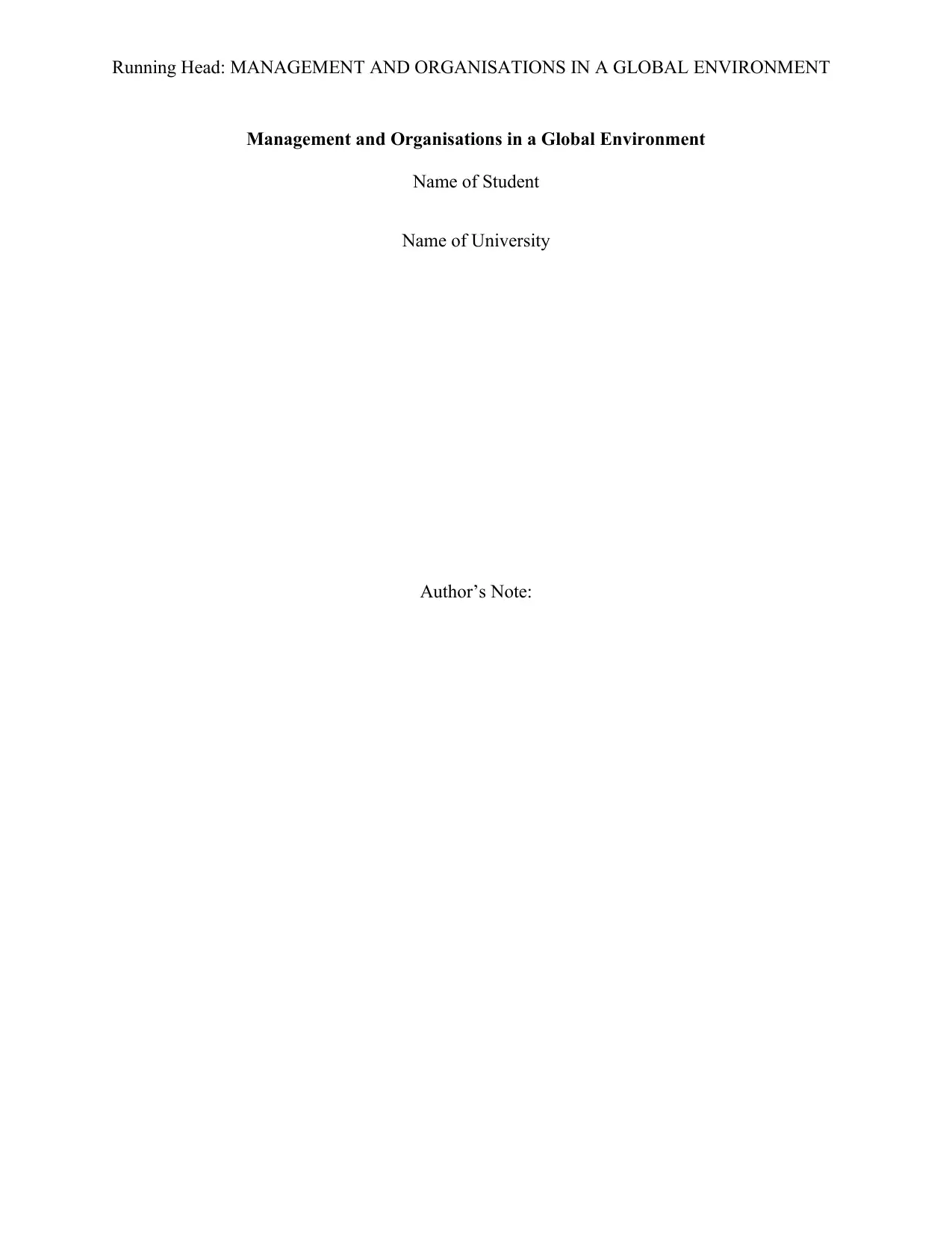
Running Head: MANAGEMENT AND ORGANISATIONS IN A GLOBAL ENVIRONMENT
Management and Organisations in a Global Environment
Name of Student
Name of University
Author’s Note:
Management and Organisations in a Global Environment
Name of Student
Name of University
Author’s Note:
Paraphrase This Document
Need a fresh take? Get an instant paraphrase of this document with our AI Paraphraser
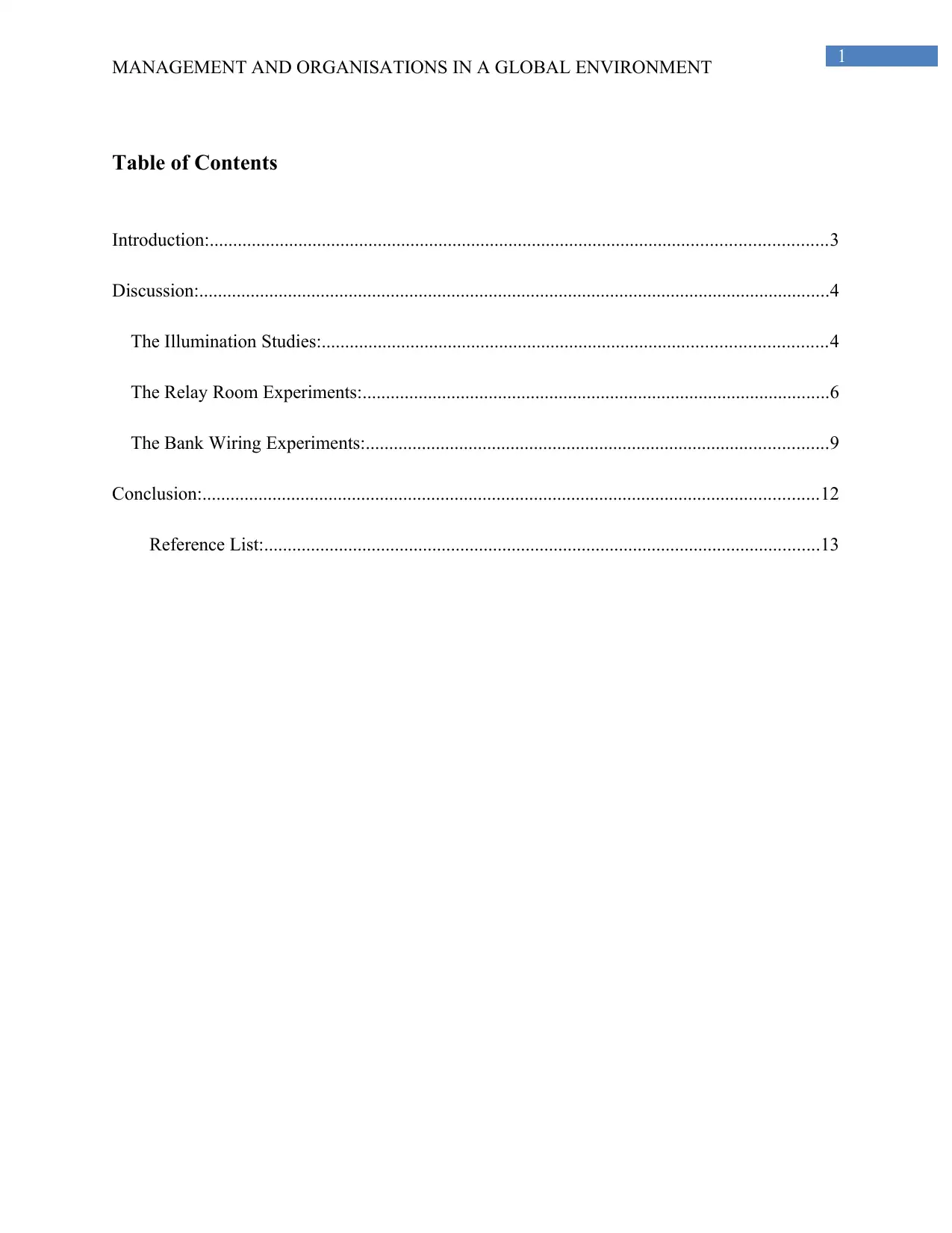
1
MANAGEMENT AND ORGANISATIONS IN A GLOBAL ENVIRONMENT
Table of Contents
Introduction:....................................................................................................................................3
Discussion:.......................................................................................................................................4
The Illumination Studies:............................................................................................................4
The Relay Room Experiments:....................................................................................................6
The Bank Wiring Experiments:...................................................................................................9
Conclusion:....................................................................................................................................12
Reference List:.......................................................................................................................13
MANAGEMENT AND ORGANISATIONS IN A GLOBAL ENVIRONMENT
Table of Contents
Introduction:....................................................................................................................................3
Discussion:.......................................................................................................................................4
The Illumination Studies:............................................................................................................4
The Relay Room Experiments:....................................................................................................6
The Bank Wiring Experiments:...................................................................................................9
Conclusion:....................................................................................................................................12
Reference List:.......................................................................................................................13
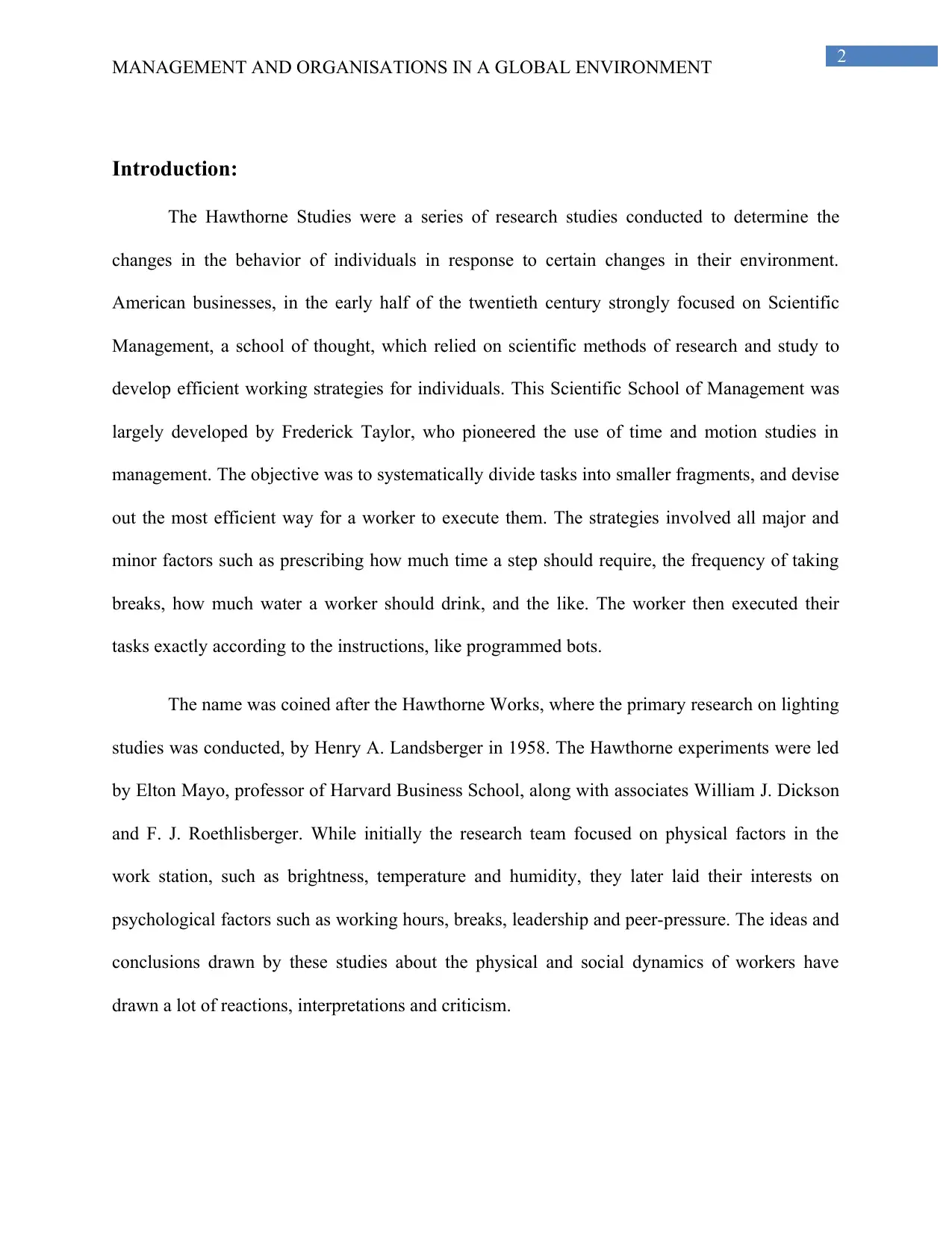
2
MANAGEMENT AND ORGANISATIONS IN A GLOBAL ENVIRONMENT
Introduction:
The Hawthorne Studies were a series of research studies conducted to determine the
changes in the behavior of individuals in response to certain changes in their environment.
American businesses, in the early half of the twentieth century strongly focused on Scientific
Management, a school of thought, which relied on scientific methods of research and study to
develop efficient working strategies for individuals. This Scientific School of Management was
largely developed by Frederick Taylor, who pioneered the use of time and motion studies in
management. The objective was to systematically divide tasks into smaller fragments, and devise
out the most efficient way for a worker to execute them. The strategies involved all major and
minor factors such as prescribing how much time a step should require, the frequency of taking
breaks, how much water a worker should drink, and the like. The worker then executed their
tasks exactly according to the instructions, like programmed bots.
The name was coined after the Hawthorne Works, where the primary research on lighting
studies was conducted, by Henry A. Landsberger in 1958. The Hawthorne experiments were led
by Elton Mayo, professor of Harvard Business School, along with associates William J. Dickson
and F. J. Roethlisberger. While initially the research team focused on physical factors in the
work station, such as brightness, temperature and humidity, they later laid their interests on
psychological factors such as working hours, breaks, leadership and peer-pressure. The ideas and
conclusions drawn by these studies about the physical and social dynamics of workers have
drawn a lot of reactions, interpretations and criticism.
MANAGEMENT AND ORGANISATIONS IN A GLOBAL ENVIRONMENT
Introduction:
The Hawthorne Studies were a series of research studies conducted to determine the
changes in the behavior of individuals in response to certain changes in their environment.
American businesses, in the early half of the twentieth century strongly focused on Scientific
Management, a school of thought, which relied on scientific methods of research and study to
develop efficient working strategies for individuals. This Scientific School of Management was
largely developed by Frederick Taylor, who pioneered the use of time and motion studies in
management. The objective was to systematically divide tasks into smaller fragments, and devise
out the most efficient way for a worker to execute them. The strategies involved all major and
minor factors such as prescribing how much time a step should require, the frequency of taking
breaks, how much water a worker should drink, and the like. The worker then executed their
tasks exactly according to the instructions, like programmed bots.
The name was coined after the Hawthorne Works, where the primary research on lighting
studies was conducted, by Henry A. Landsberger in 1958. The Hawthorne experiments were led
by Elton Mayo, professor of Harvard Business School, along with associates William J. Dickson
and F. J. Roethlisberger. While initially the research team focused on physical factors in the
work station, such as brightness, temperature and humidity, they later laid their interests on
psychological factors such as working hours, breaks, leadership and peer-pressure. The ideas and
conclusions drawn by these studies about the physical and social dynamics of workers have
drawn a lot of reactions, interpretations and criticism.
⊘ This is a preview!⊘
Do you want full access?
Subscribe today to unlock all pages.

Trusted by 1+ million students worldwide
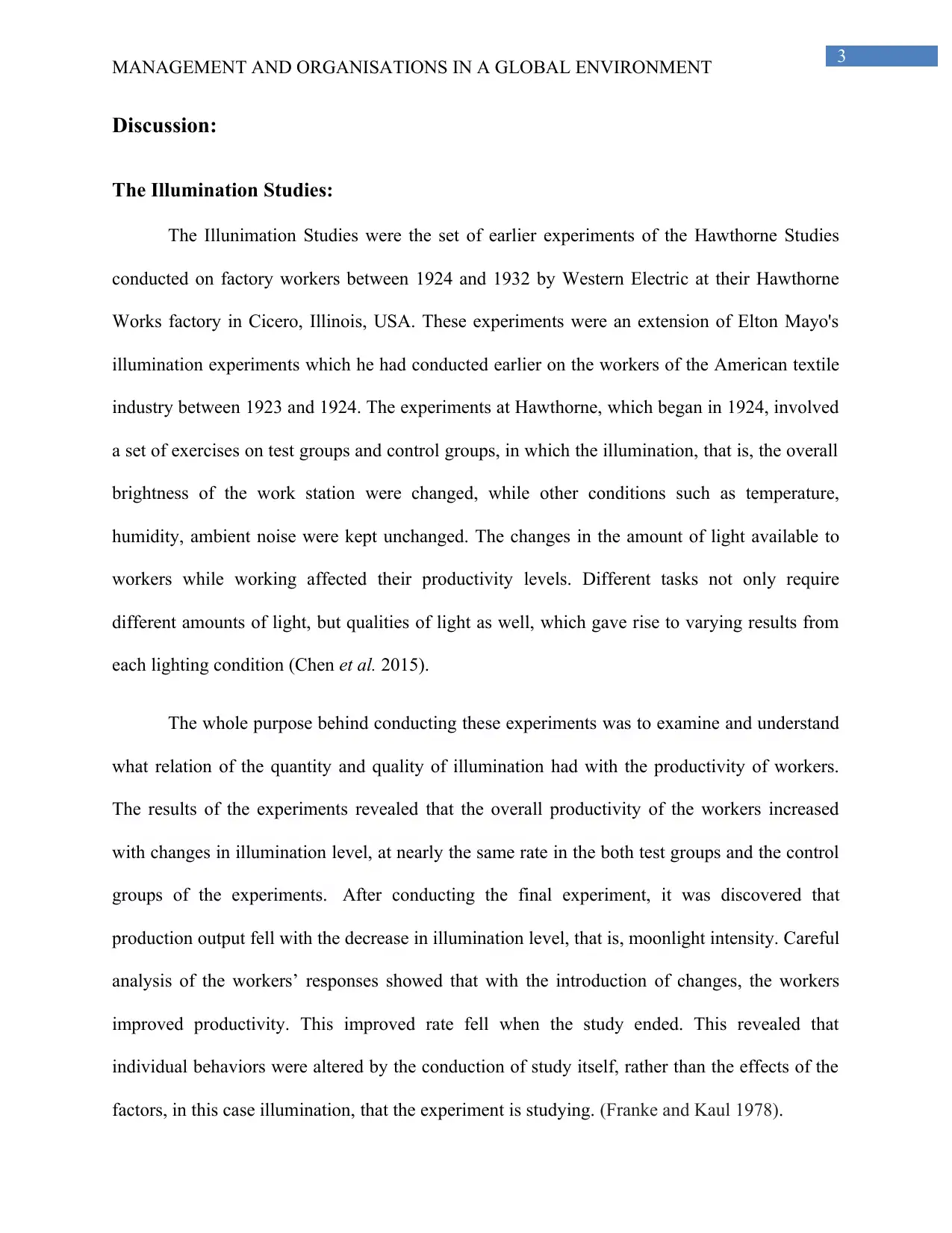
3
MANAGEMENT AND ORGANISATIONS IN A GLOBAL ENVIRONMENT
Discussion:
The Illumination Studies:
The Illunimation Studies were the set of earlier experiments of the Hawthorne Studies
conducted on factory workers between 1924 and 1932 by Western Electric at their Hawthorne
Works factory in Cicero, Illinois, USA. These experiments were an extension of Elton Mayo's
illumination experiments which he had conducted earlier on the workers of the American textile
industry between 1923 and 1924. The experiments at Hawthorne, which began in 1924, involved
a set of exercises on test groups and control groups, in which the illumination, that is, the overall
brightness of the work station were changed, while other conditions such as temperature,
humidity, ambient noise were kept unchanged. The changes in the amount of light available to
workers while working affected their productivity levels. Different tasks not only require
different amounts of light, but qualities of light as well, which gave rise to varying results from
each lighting condition (Chen et al. 2015).
The whole purpose behind conducting these experiments was to examine and understand
what relation of the quantity and quality of illumination had with the productivity of workers.
The results of the experiments revealed that the overall productivity of the workers increased
with changes in illumination level, at nearly the same rate in the both test groups and the control
groups of the experiments. After conducting the final experiment, it was discovered that
production output fell with the decrease in illumination level, that is, moonlight intensity. Careful
analysis of the workers’ responses showed that with the introduction of changes, the workers
improved productivity. This improved rate fell when the study ended. This revealed that
individual behaviors were altered by the conduction of study itself, rather than the effects of the
factors, in this case illumination, that the experiment is studying. (Franke and Kaul 1978).
MANAGEMENT AND ORGANISATIONS IN A GLOBAL ENVIRONMENT
Discussion:
The Illumination Studies:
The Illunimation Studies were the set of earlier experiments of the Hawthorne Studies
conducted on factory workers between 1924 and 1932 by Western Electric at their Hawthorne
Works factory in Cicero, Illinois, USA. These experiments were an extension of Elton Mayo's
illumination experiments which he had conducted earlier on the workers of the American textile
industry between 1923 and 1924. The experiments at Hawthorne, which began in 1924, involved
a set of exercises on test groups and control groups, in which the illumination, that is, the overall
brightness of the work station were changed, while other conditions such as temperature,
humidity, ambient noise were kept unchanged. The changes in the amount of light available to
workers while working affected their productivity levels. Different tasks not only require
different amounts of light, but qualities of light as well, which gave rise to varying results from
each lighting condition (Chen et al. 2015).
The whole purpose behind conducting these experiments was to examine and understand
what relation of the quantity and quality of illumination had with the productivity of workers.
The results of the experiments revealed that the overall productivity of the workers increased
with changes in illumination level, at nearly the same rate in the both test groups and the control
groups of the experiments. After conducting the final experiment, it was discovered that
production output fell with the decrease in illumination level, that is, moonlight intensity. Careful
analysis of the workers’ responses showed that with the introduction of changes, the workers
improved productivity. This improved rate fell when the study ended. This revealed that
individual behaviors were altered by the conduction of study itself, rather than the effects of the
factors, in this case illumination, that the experiment is studying. (Franke and Kaul 1978).
Paraphrase This Document
Need a fresh take? Get an instant paraphrase of this document with our AI Paraphraser
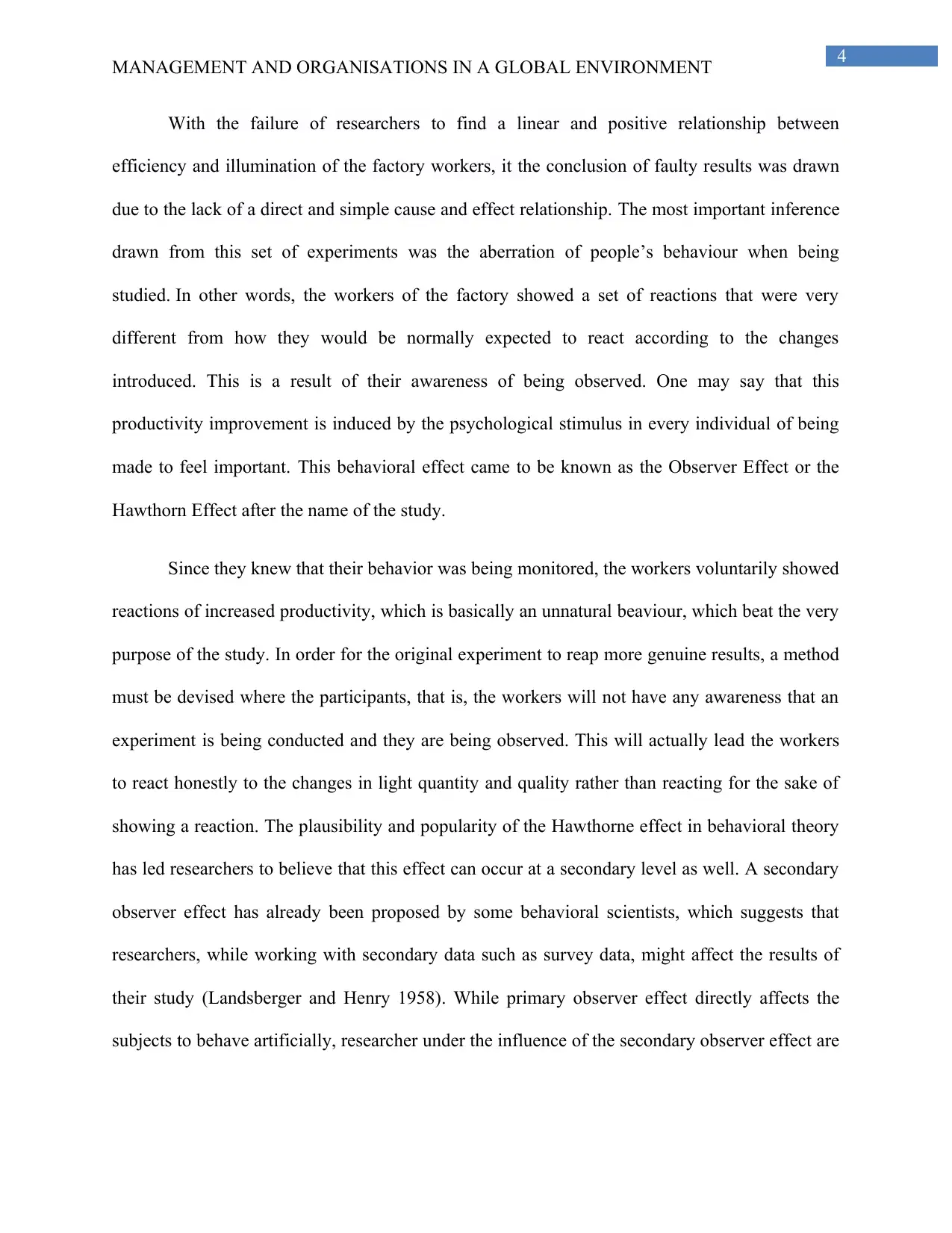
4
MANAGEMENT AND ORGANISATIONS IN A GLOBAL ENVIRONMENT
With the failure of researchers to find a linear and positive relationship between
efficiency and illumination of the factory workers, it the conclusion of faulty results was drawn
due to the lack of a direct and simple cause and effect relationship. The most important inference
drawn from this set of experiments was the aberration of people’s behaviour when being
studied. In other words, the workers of the factory showed a set of reactions that were very
different from how they would be normally expected to react according to the changes
introduced. This is a result of their awareness of being observed. One may say that this
productivity improvement is induced by the psychological stimulus in every individual of being
made to feel important. This behavioral effect came to be known as the Observer Effect or the
Hawthorn Effect after the name of the study.
Since they knew that their behavior was being monitored, the workers voluntarily showed
reactions of increased productivity, which is basically an unnatural beaviour, which beat the very
purpose of the study. In order for the original experiment to reap more genuine results, a method
must be devised where the participants, that is, the workers will not have any awareness that an
experiment is being conducted and they are being observed. This will actually lead the workers
to react honestly to the changes in light quantity and quality rather than reacting for the sake of
showing a reaction. The plausibility and popularity of the Hawthorne effect in behavioral theory
has led researchers to believe that this effect can occur at a secondary level as well. A secondary
observer effect has already been proposed by some behavioral scientists, which suggests that
researchers, while working with secondary data such as survey data, might affect the results of
their study (Landsberger and Henry 1958). While primary observer effect directly affects the
subjects to behave artificially, researcher under the influence of the secondary observer effect are
MANAGEMENT AND ORGANISATIONS IN A GLOBAL ENVIRONMENT
With the failure of researchers to find a linear and positive relationship between
efficiency and illumination of the factory workers, it the conclusion of faulty results was drawn
due to the lack of a direct and simple cause and effect relationship. The most important inference
drawn from this set of experiments was the aberration of people’s behaviour when being
studied. In other words, the workers of the factory showed a set of reactions that were very
different from how they would be normally expected to react according to the changes
introduced. This is a result of their awareness of being observed. One may say that this
productivity improvement is induced by the psychological stimulus in every individual of being
made to feel important. This behavioral effect came to be known as the Observer Effect or the
Hawthorn Effect after the name of the study.
Since they knew that their behavior was being monitored, the workers voluntarily showed
reactions of increased productivity, which is basically an unnatural beaviour, which beat the very
purpose of the study. In order for the original experiment to reap more genuine results, a method
must be devised where the participants, that is, the workers will not have any awareness that an
experiment is being conducted and they are being observed. This will actually lead the workers
to react honestly to the changes in light quantity and quality rather than reacting for the sake of
showing a reaction. The plausibility and popularity of the Hawthorne effect in behavioral theory
has led researchers to believe that this effect can occur at a secondary level as well. A secondary
observer effect has already been proposed by some behavioral scientists, which suggests that
researchers, while working with secondary data such as survey data, might affect the results of
their study (Landsberger and Henry 1958). While primary observer effect directly affects the
subjects to behave artificially, researcher under the influence of the secondary observer effect are
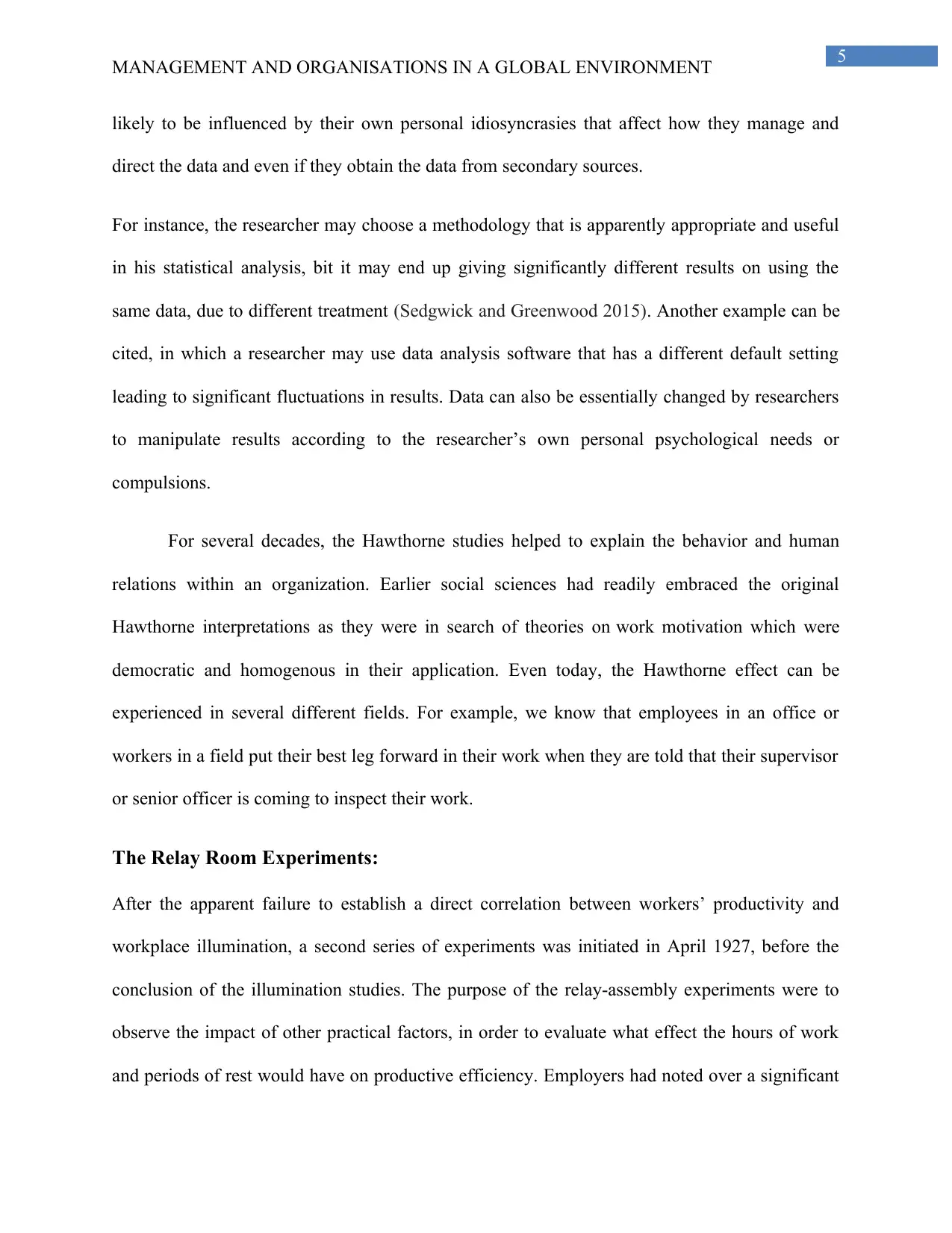
5
MANAGEMENT AND ORGANISATIONS IN A GLOBAL ENVIRONMENT
likely to be influenced by their own personal idiosyncrasies that affect how they manage and
direct the data and even if they obtain the data from secondary sources.
For instance, the researcher may choose a methodology that is apparently appropriate and useful
in his statistical analysis, bit it may end up giving significantly different results on using the
same data, due to different treatment (Sedgwick and Greenwood 2015). Another example can be
cited, in which a researcher may use data analysis software that has a different default setting
leading to significant fluctuations in results. Data can also be essentially changed by researchers
to manipulate results according to the researcher’s own personal psychological needs or
compulsions.
For several decades, the Hawthorne studies helped to explain the behavior and human
relations within an organization. Earlier social sciences had readily embraced the original
Hawthorne interpretations as they were in search of theories on work motivation which were
democratic and homogenous in their application. Even today, the Hawthorne effect can be
experienced in several different fields. For example, we know that employees in an office or
workers in a field put their best leg forward in their work when they are told that their supervisor
or senior officer is coming to inspect their work.
The Relay Room Experiments:
After the apparent failure to establish a direct correlation between workers’ productivity and
workplace illumination, a second series of experiments was initiated in April 1927, before the
conclusion of the illumination studies. The purpose of the relay-assembly experiments were to
observe the impact of other practical factors, in order to evaluate what effect the hours of work
and periods of rest would have on productive efficiency. Employers had noted over a significant
MANAGEMENT AND ORGANISATIONS IN A GLOBAL ENVIRONMENT
likely to be influenced by their own personal idiosyncrasies that affect how they manage and
direct the data and even if they obtain the data from secondary sources.
For instance, the researcher may choose a methodology that is apparently appropriate and useful
in his statistical analysis, bit it may end up giving significantly different results on using the
same data, due to different treatment (Sedgwick and Greenwood 2015). Another example can be
cited, in which a researcher may use data analysis software that has a different default setting
leading to significant fluctuations in results. Data can also be essentially changed by researchers
to manipulate results according to the researcher’s own personal psychological needs or
compulsions.
For several decades, the Hawthorne studies helped to explain the behavior and human
relations within an organization. Earlier social sciences had readily embraced the original
Hawthorne interpretations as they were in search of theories on work motivation which were
democratic and homogenous in their application. Even today, the Hawthorne effect can be
experienced in several different fields. For example, we know that employees in an office or
workers in a field put their best leg forward in their work when they are told that their supervisor
or senior officer is coming to inspect their work.
The Relay Room Experiments:
After the apparent failure to establish a direct correlation between workers’ productivity and
workplace illumination, a second series of experiments was initiated in April 1927, before the
conclusion of the illumination studies. The purpose of the relay-assembly experiments were to
observe the impact of other practical factors, in order to evaluate what effect the hours of work
and periods of rest would have on productive efficiency. Employers had noted over a significant
⊘ This is a preview!⊘
Do you want full access?
Subscribe today to unlock all pages.

Trusted by 1+ million students worldwide
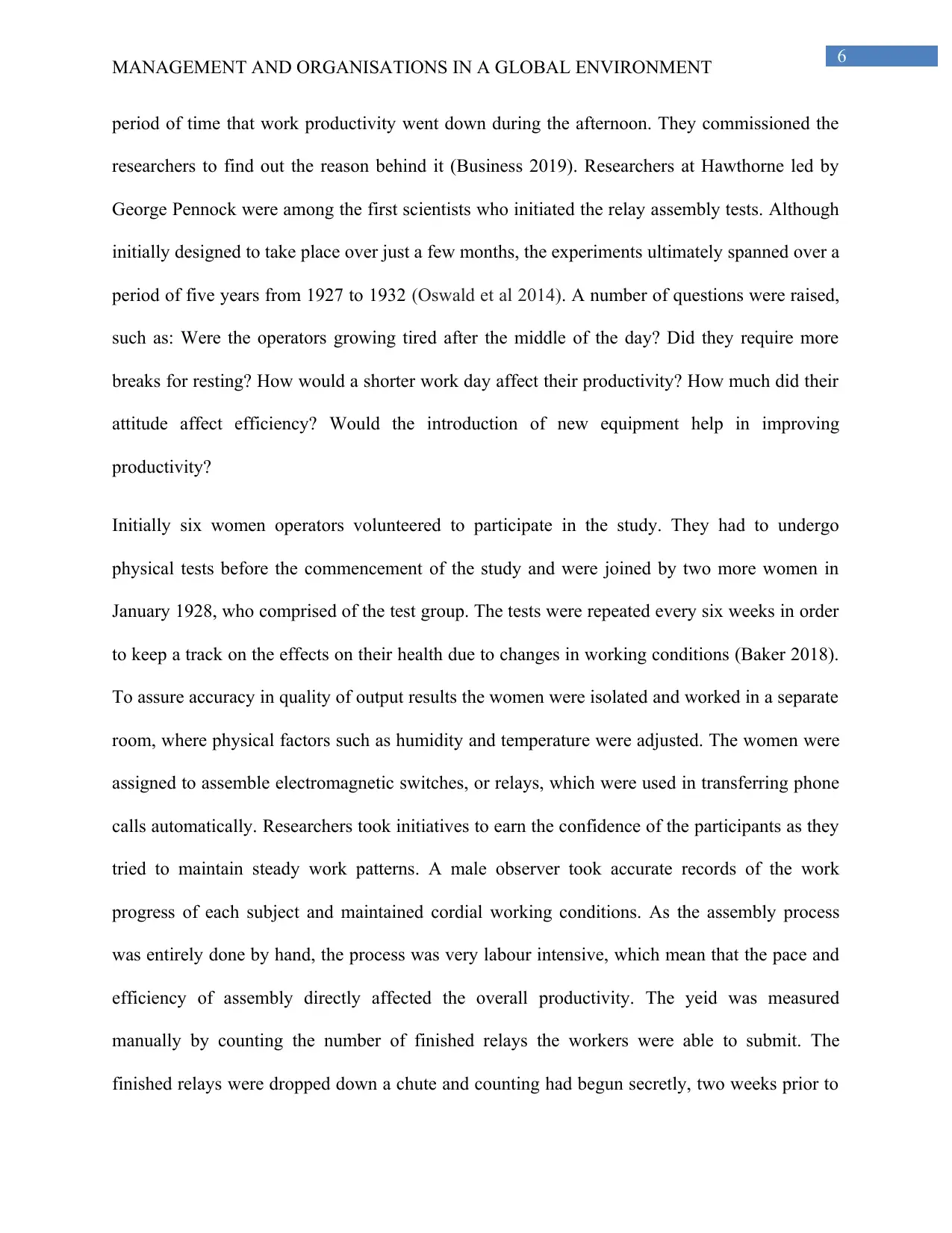
6
MANAGEMENT AND ORGANISATIONS IN A GLOBAL ENVIRONMENT
period of time that work productivity went down during the afternoon. They commissioned the
researchers to find out the reason behind it (Business 2019). Researchers at Hawthorne led by
George Pennock were among the first scientists who initiated the relay assembly tests. Although
initially designed to take place over just a few months, the experiments ultimately spanned over a
period of five years from 1927 to 1932 (Oswald et al 2014). A number of questions were raised,
such as: Were the operators growing tired after the middle of the day? Did they require more
breaks for resting? How would a shorter work day affect their productivity? How much did their
attitude affect efficiency? Would the introduction of new equipment help in improving
productivity?
Initially six women operators volunteered to participate in the study. They had to undergo
physical tests before the commencement of the study and were joined by two more women in
January 1928, who comprised of the test group. The tests were repeated every six weeks in order
to keep a track on the effects on their health due to changes in working conditions (Baker 2018).
To assure accuracy in quality of output results the women were isolated and worked in a separate
room, where physical factors such as humidity and temperature were adjusted. The women were
assigned to assemble electromagnetic switches, or relays, which were used in transferring phone
calls automatically. Researchers took initiatives to earn the confidence of the participants as they
tried to maintain steady work patterns. A male observer took accurate records of the work
progress of each subject and maintained cordial working conditions. As the assembly process
was entirely done by hand, the process was very labour intensive, which mean that the pace and
efficiency of assembly directly affected the overall productivity. The yeid was measured
manually by counting the number of finished relays the workers were able to submit. The
finished relays were dropped down a chute and counting had begun secretly, two weeks prior to
MANAGEMENT AND ORGANISATIONS IN A GLOBAL ENVIRONMENT
period of time that work productivity went down during the afternoon. They commissioned the
researchers to find out the reason behind it (Business 2019). Researchers at Hawthorne led by
George Pennock were among the first scientists who initiated the relay assembly tests. Although
initially designed to take place over just a few months, the experiments ultimately spanned over a
period of five years from 1927 to 1932 (Oswald et al 2014). A number of questions were raised,
such as: Were the operators growing tired after the middle of the day? Did they require more
breaks for resting? How would a shorter work day affect their productivity? How much did their
attitude affect efficiency? Would the introduction of new equipment help in improving
productivity?
Initially six women operators volunteered to participate in the study. They had to undergo
physical tests before the commencement of the study and were joined by two more women in
January 1928, who comprised of the test group. The tests were repeated every six weeks in order
to keep a track on the effects on their health due to changes in working conditions (Baker 2018).
To assure accuracy in quality of output results the women were isolated and worked in a separate
room, where physical factors such as humidity and temperature were adjusted. The women were
assigned to assemble electromagnetic switches, or relays, which were used in transferring phone
calls automatically. Researchers took initiatives to earn the confidence of the participants as they
tried to maintain steady work patterns. A male observer took accurate records of the work
progress of each subject and maintained cordial working conditions. As the assembly process
was entirely done by hand, the process was very labour intensive, which mean that the pace and
efficiency of assembly directly affected the overall productivity. The yeid was measured
manually by counting the number of finished relays the workers were able to submit. The
finished relays were dropped down a chute and counting had begun secretly, two weeks prior to
Paraphrase This Document
Need a fresh take? Get an instant paraphrase of this document with our AI Paraphraser
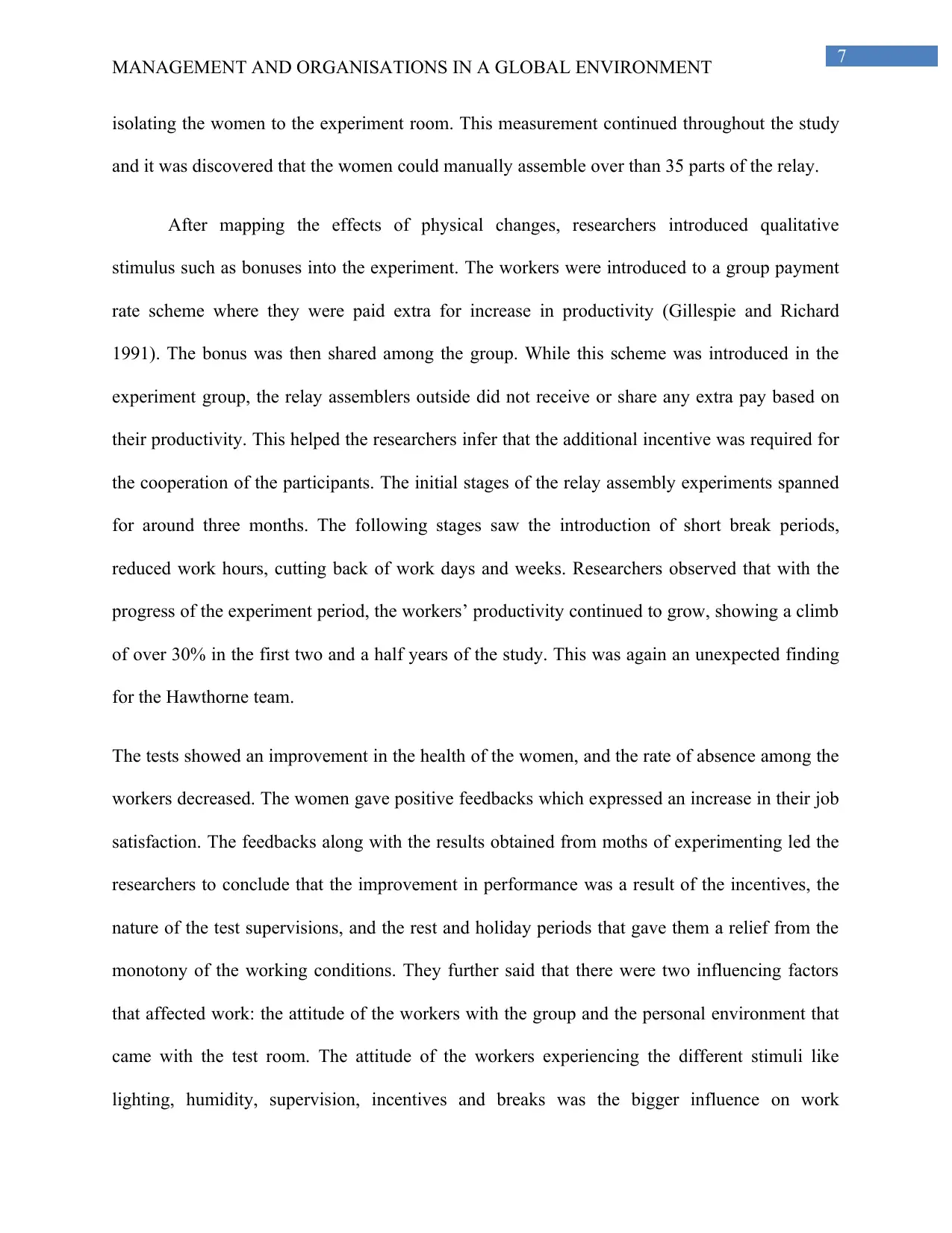
7
MANAGEMENT AND ORGANISATIONS IN A GLOBAL ENVIRONMENT
isolating the women to the experiment room. This measurement continued throughout the study
and it was discovered that the women could manually assemble over than 35 parts of the relay.
After mapping the effects of physical changes, researchers introduced qualitative
stimulus such as bonuses into the experiment. The workers were introduced to a group payment
rate scheme where they were paid extra for increase in productivity (Gillespie and Richard
1991). The bonus was then shared among the group. While this scheme was introduced in the
experiment group, the relay assemblers outside did not receive or share any extra pay based on
their productivity. This helped the researchers infer that the additional incentive was required for
the cooperation of the participants. The initial stages of the relay assembly experiments spanned
for around three months. The following stages saw the introduction of short break periods,
reduced work hours, cutting back of work days and weeks. Researchers observed that with the
progress of the experiment period, the workers’ productivity continued to grow, showing a climb
of over 30% in the first two and a half years of the study. This was again an unexpected finding
for the Hawthorne team.
The tests showed an improvement in the health of the women, and the rate of absence among the
workers decreased. The women gave positive feedbacks which expressed an increase in their job
satisfaction. The feedbacks along with the results obtained from moths of experimenting led the
researchers to conclude that the improvement in performance was a result of the incentives, the
nature of the test supervisions, and the rest and holiday periods that gave them a relief from the
monotony of the working conditions. They further said that there were two influencing factors
that affected work: the attitude of the workers with the group and the personal environment that
came with the test room. The attitude of the workers experiencing the different stimuli like
lighting, humidity, supervision, incentives and breaks was the bigger influence on work
MANAGEMENT AND ORGANISATIONS IN A GLOBAL ENVIRONMENT
isolating the women to the experiment room. This measurement continued throughout the study
and it was discovered that the women could manually assemble over than 35 parts of the relay.
After mapping the effects of physical changes, researchers introduced qualitative
stimulus such as bonuses into the experiment. The workers were introduced to a group payment
rate scheme where they were paid extra for increase in productivity (Gillespie and Richard
1991). The bonus was then shared among the group. While this scheme was introduced in the
experiment group, the relay assemblers outside did not receive or share any extra pay based on
their productivity. This helped the researchers infer that the additional incentive was required for
the cooperation of the participants. The initial stages of the relay assembly experiments spanned
for around three months. The following stages saw the introduction of short break periods,
reduced work hours, cutting back of work days and weeks. Researchers observed that with the
progress of the experiment period, the workers’ productivity continued to grow, showing a climb
of over 30% in the first two and a half years of the study. This was again an unexpected finding
for the Hawthorne team.
The tests showed an improvement in the health of the women, and the rate of absence among the
workers decreased. The women gave positive feedbacks which expressed an increase in their job
satisfaction. The feedbacks along with the results obtained from moths of experimenting led the
researchers to conclude that the improvement in performance was a result of the incentives, the
nature of the test supervisions, and the rest and holiday periods that gave them a relief from the
monotony of the working conditions. They further said that there were two influencing factors
that affected work: the attitude of the workers with the group and the personal environment that
came with the test room. The attitude of the workers experiencing the different stimuli like
lighting, humidity, supervision, incentives and breaks was the bigger influence on work
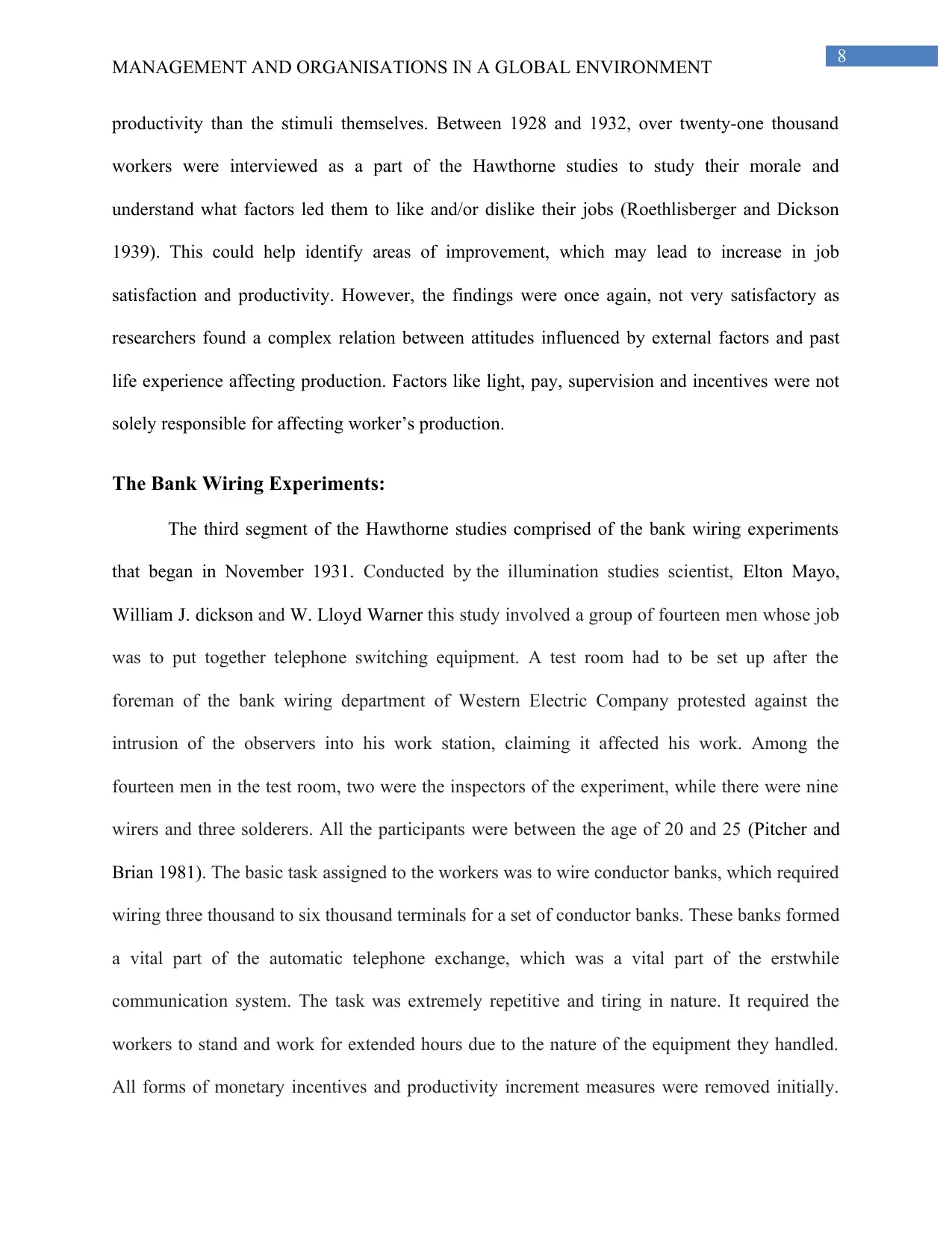
8
MANAGEMENT AND ORGANISATIONS IN A GLOBAL ENVIRONMENT
productivity than the stimuli themselves. Between 1928 and 1932, over twenty-one thousand
workers were interviewed as a part of the Hawthorne studies to study their morale and
understand what factors led them to like and/or dislike their jobs (Roethlisberger and Dickson
1939). This could help identify areas of improvement, which may lead to increase in job
satisfaction and productivity. However, the findings were once again, not very satisfactory as
researchers found a complex relation between attitudes influenced by external factors and past
life experience affecting production. Factors like light, pay, supervision and incentives were not
solely responsible for affecting worker’s production.
The Bank Wiring Experiments:
The third segment of the Hawthorne studies comprised of the bank wiring experiments
that began in November 1931. Conducted by the illumination studies scientist, Elton Mayo,
William J. dickson and W. Lloyd Warner this study involved a group of fourteen men whose job
was to put together telephone switching equipment. A test room had to be set up after the
foreman of the bank wiring department of Western Electric Company protested against the
intrusion of the observers into his work station, claiming it affected his work. Among the
fourteen men in the test room, two were the inspectors of the experiment, while there were nine
wirers and three solderers. All the participants were between the age of 20 and 25 (Pitcher and
Brian 1981). The basic task assigned to the workers was to wire conductor banks, which required
wiring three thousand to six thousand terminals for a set of conductor banks. These banks formed
a vital part of the automatic telephone exchange, which was a vital part of the erstwhile
communication system. The task was extremely repetitive and tiring in nature. It required the
workers to stand and work for extended hours due to the nature of the equipment they handled.
All forms of monetary incentives and productivity increment measures were removed initially.
MANAGEMENT AND ORGANISATIONS IN A GLOBAL ENVIRONMENT
productivity than the stimuli themselves. Between 1928 and 1932, over twenty-one thousand
workers were interviewed as a part of the Hawthorne studies to study their morale and
understand what factors led them to like and/or dislike their jobs (Roethlisberger and Dickson
1939). This could help identify areas of improvement, which may lead to increase in job
satisfaction and productivity. However, the findings were once again, not very satisfactory as
researchers found a complex relation between attitudes influenced by external factors and past
life experience affecting production. Factors like light, pay, supervision and incentives were not
solely responsible for affecting worker’s production.
The Bank Wiring Experiments:
The third segment of the Hawthorne studies comprised of the bank wiring experiments
that began in November 1931. Conducted by the illumination studies scientist, Elton Mayo,
William J. dickson and W. Lloyd Warner this study involved a group of fourteen men whose job
was to put together telephone switching equipment. A test room had to be set up after the
foreman of the bank wiring department of Western Electric Company protested against the
intrusion of the observers into his work station, claiming it affected his work. Among the
fourteen men in the test room, two were the inspectors of the experiment, while there were nine
wirers and three solderers. All the participants were between the age of 20 and 25 (Pitcher and
Brian 1981). The basic task assigned to the workers was to wire conductor banks, which required
wiring three thousand to six thousand terminals for a set of conductor banks. These banks formed
a vital part of the automatic telephone exchange, which was a vital part of the erstwhile
communication system. The task was extremely repetitive and tiring in nature. It required the
workers to stand and work for extended hours due to the nature of the equipment they handled.
All forms of monetary incentives and productivity increment measures were removed initially.
⊘ This is a preview!⊘
Do you want full access?
Subscribe today to unlock all pages.

Trusted by 1+ million students worldwide
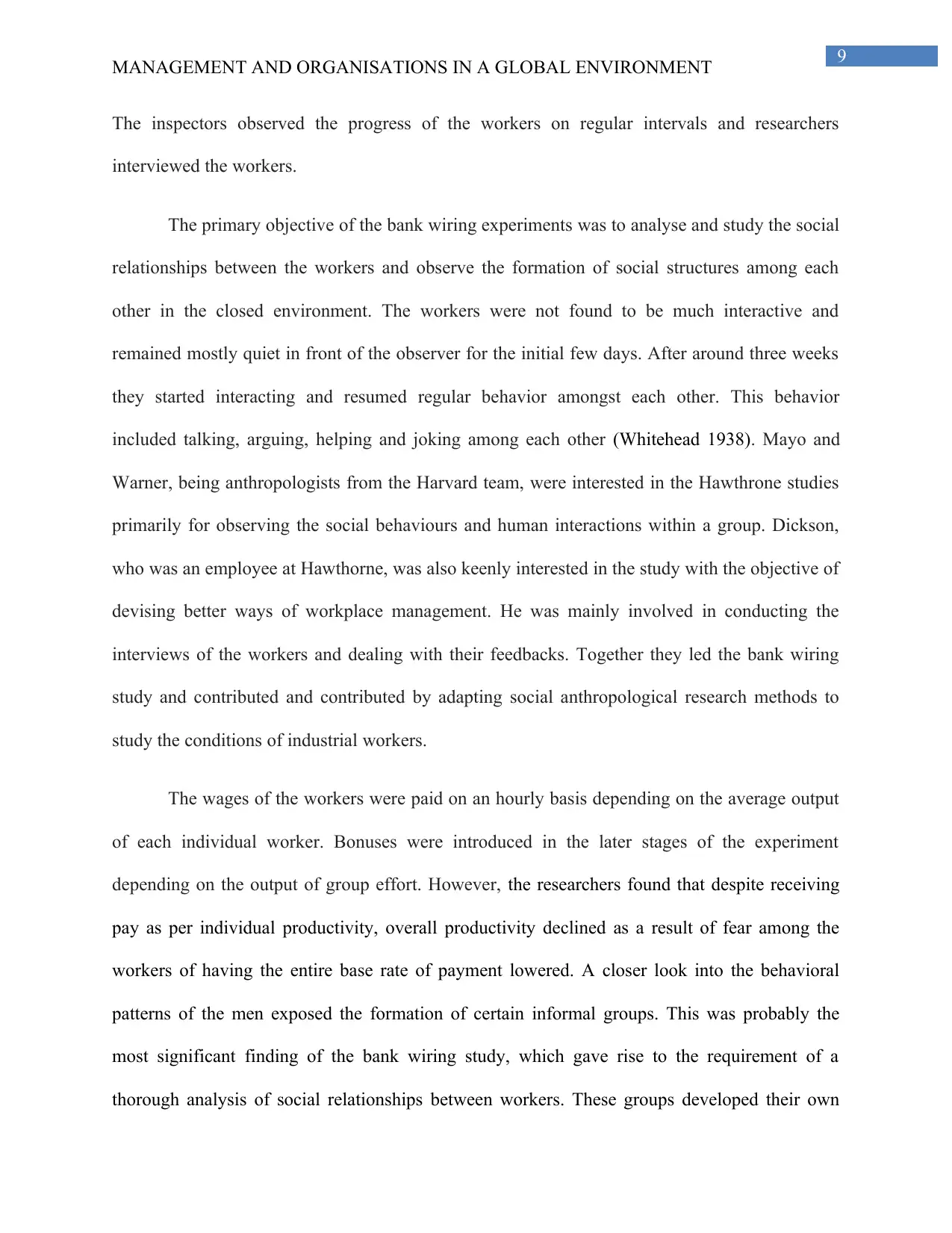
9
MANAGEMENT AND ORGANISATIONS IN A GLOBAL ENVIRONMENT
The inspectors observed the progress of the workers on regular intervals and researchers
interviewed the workers.
The primary objective of the bank wiring experiments was to analyse and study the social
relationships between the workers and observe the formation of social structures among each
other in the closed environment. The workers were not found to be much interactive and
remained mostly quiet in front of the observer for the initial few days. After around three weeks
they started interacting and resumed regular behavior amongst each other. This behavior
included talking, arguing, helping and joking among each other (Whitehead 1938). Mayo and
Warner, being anthropologists from the Harvard team, were interested in the Hawthrone studies
primarily for observing the social behaviours and human interactions within a group. Dickson,
who was an employee at Hawthorne, was also keenly interested in the study with the objective of
devising better ways of workplace management. He was mainly involved in conducting the
interviews of the workers and dealing with their feedbacks. Together they led the bank wiring
study and contributed and contributed by adapting social anthropological research methods to
study the conditions of industrial workers.
The wages of the workers were paid on an hourly basis depending on the average output
of each individual worker. Bonuses were introduced in the later stages of the experiment
depending on the output of group effort. However, the researchers found that despite receiving
pay as per individual productivity, overall productivity declined as a result of fear among the
workers of having the entire base rate of payment lowered. A closer look into the behavioral
patterns of the men exposed the formation of certain informal groups. This was probably the
most significant finding of the bank wiring study, which gave rise to the requirement of a
thorough analysis of social relationships between workers. These groups developed their own
MANAGEMENT AND ORGANISATIONS IN A GLOBAL ENVIRONMENT
The inspectors observed the progress of the workers on regular intervals and researchers
interviewed the workers.
The primary objective of the bank wiring experiments was to analyse and study the social
relationships between the workers and observe the formation of social structures among each
other in the closed environment. The workers were not found to be much interactive and
remained mostly quiet in front of the observer for the initial few days. After around three weeks
they started interacting and resumed regular behavior amongst each other. This behavior
included talking, arguing, helping and joking among each other (Whitehead 1938). Mayo and
Warner, being anthropologists from the Harvard team, were interested in the Hawthrone studies
primarily for observing the social behaviours and human interactions within a group. Dickson,
who was an employee at Hawthorne, was also keenly interested in the study with the objective of
devising better ways of workplace management. He was mainly involved in conducting the
interviews of the workers and dealing with their feedbacks. Together they led the bank wiring
study and contributed and contributed by adapting social anthropological research methods to
study the conditions of industrial workers.
The wages of the workers were paid on an hourly basis depending on the average output
of each individual worker. Bonuses were introduced in the later stages of the experiment
depending on the output of group effort. However, the researchers found that despite receiving
pay as per individual productivity, overall productivity declined as a result of fear among the
workers of having the entire base rate of payment lowered. A closer look into the behavioral
patterns of the men exposed the formation of certain informal groups. This was probably the
most significant finding of the bank wiring study, which gave rise to the requirement of a
thorough analysis of social relationships between workers. These groups developed their own
Paraphrase This Document
Need a fresh take? Get an instant paraphrase of this document with our AI Paraphraser
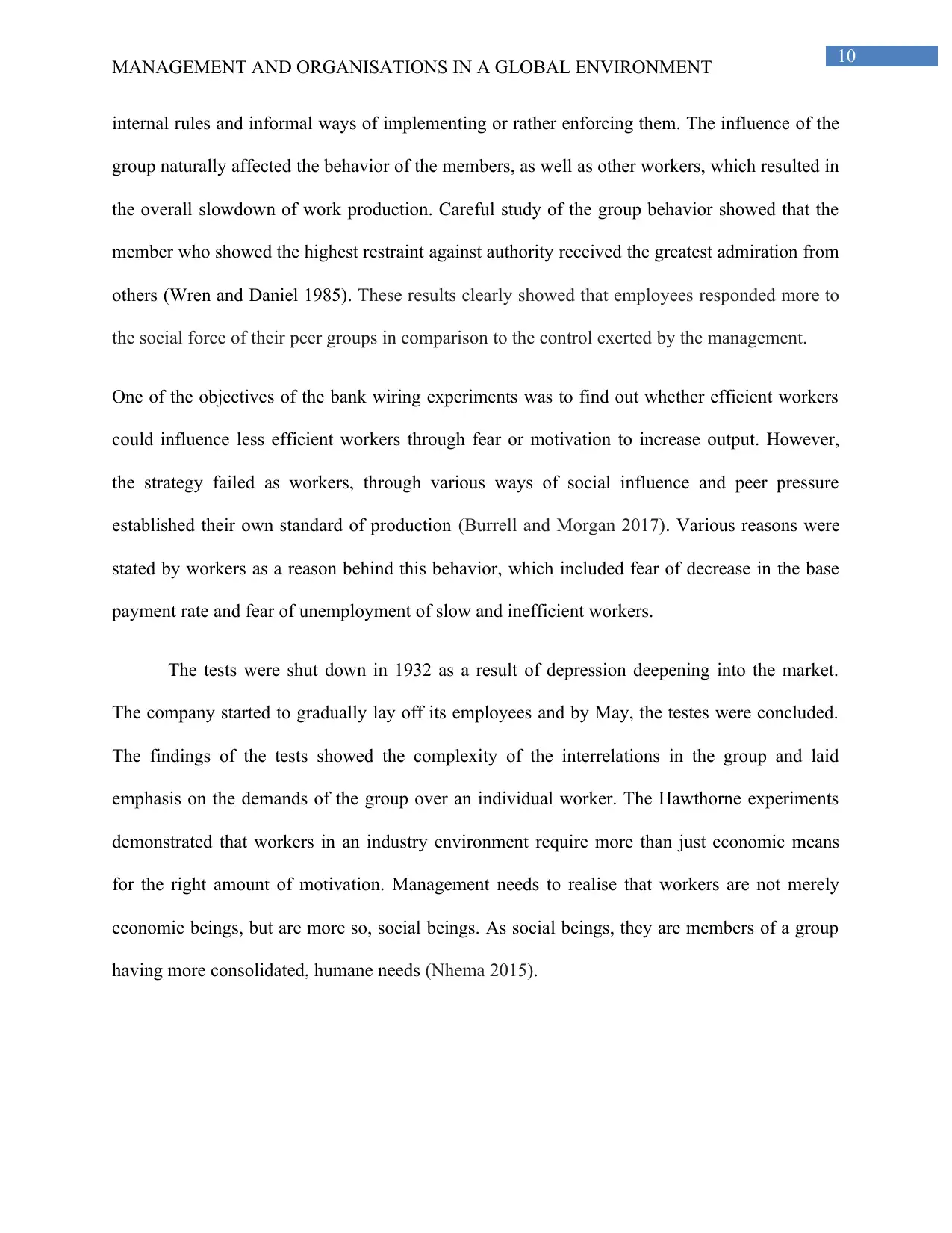
10
MANAGEMENT AND ORGANISATIONS IN A GLOBAL ENVIRONMENT
internal rules and informal ways of implementing or rather enforcing them. The influence of the
group naturally affected the behavior of the members, as well as other workers, which resulted in
the overall slowdown of work production. Careful study of the group behavior showed that the
member who showed the highest restraint against authority received the greatest admiration from
others (Wren and Daniel 1985). These results clearly showed that employees responded more to
the social force of their peer groups in comparison to the control exerted by the management.
One of the objectives of the bank wiring experiments was to find out whether efficient workers
could influence less efficient workers through fear or motivation to increase output. However,
the strategy failed as workers, through various ways of social influence and peer pressure
established their own standard of production (Burrell and Morgan 2017). Various reasons were
stated by workers as a reason behind this behavior, which included fear of decrease in the base
payment rate and fear of unemployment of slow and inefficient workers.
The tests were shut down in 1932 as a result of depression deepening into the market.
The company started to gradually lay off its employees and by May, the testes were concluded.
The findings of the tests showed the complexity of the interrelations in the group and laid
emphasis on the demands of the group over an individual worker. The Hawthorne experiments
demonstrated that workers in an industry environment require more than just economic means
for the right amount of motivation. Management needs to realise that workers are not merely
economic beings, but are more so, social beings. As social beings, they are members of a group
having more consolidated, humane needs (Nhema 2015).
MANAGEMENT AND ORGANISATIONS IN A GLOBAL ENVIRONMENT
internal rules and informal ways of implementing or rather enforcing them. The influence of the
group naturally affected the behavior of the members, as well as other workers, which resulted in
the overall slowdown of work production. Careful study of the group behavior showed that the
member who showed the highest restraint against authority received the greatest admiration from
others (Wren and Daniel 1985). These results clearly showed that employees responded more to
the social force of their peer groups in comparison to the control exerted by the management.
One of the objectives of the bank wiring experiments was to find out whether efficient workers
could influence less efficient workers through fear or motivation to increase output. However,
the strategy failed as workers, through various ways of social influence and peer pressure
established their own standard of production (Burrell and Morgan 2017). Various reasons were
stated by workers as a reason behind this behavior, which included fear of decrease in the base
payment rate and fear of unemployment of slow and inefficient workers.
The tests were shut down in 1932 as a result of depression deepening into the market.
The company started to gradually lay off its employees and by May, the testes were concluded.
The findings of the tests showed the complexity of the interrelations in the group and laid
emphasis on the demands of the group over an individual worker. The Hawthorne experiments
demonstrated that workers in an industry environment require more than just economic means
for the right amount of motivation. Management needs to realise that workers are not merely
economic beings, but are more so, social beings. As social beings, they are members of a group
having more consolidated, humane needs (Nhema 2015).
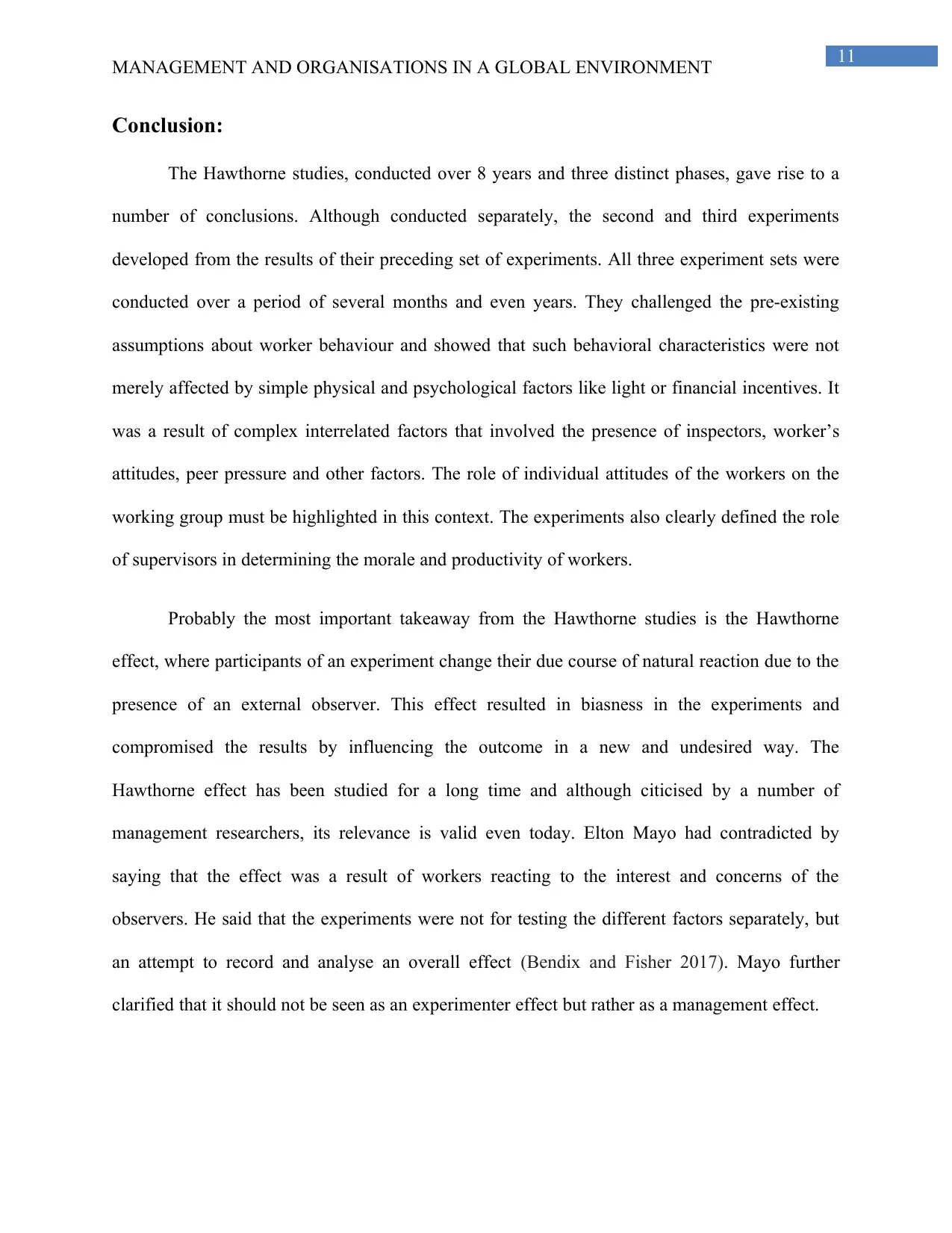
11
MANAGEMENT AND ORGANISATIONS IN A GLOBAL ENVIRONMENT
Conclusion:
The Hawthorne studies, conducted over 8 years and three distinct phases, gave rise to a
number of conclusions. Although conducted separately, the second and third experiments
developed from the results of their preceding set of experiments. All three experiment sets were
conducted over a period of several months and even years. They challenged the pre-existing
assumptions about worker behaviour and showed that such behavioral characteristics were not
merely affected by simple physical and psychological factors like light or financial incentives. It
was a result of complex interrelated factors that involved the presence of inspectors, worker’s
attitudes, peer pressure and other factors. The role of individual attitudes of the workers on the
working group must be highlighted in this context. The experiments also clearly defined the role
of supervisors in determining the morale and productivity of workers.
Probably the most important takeaway from the Hawthorne studies is the Hawthorne
effect, where participants of an experiment change their due course of natural reaction due to the
presence of an external observer. This effect resulted in biasness in the experiments and
compromised the results by influencing the outcome in a new and undesired way. The
Hawthorne effect has been studied for a long time and although citicised by a number of
management researchers, its relevance is valid even today. Elton Mayo had contradicted by
saying that the effect was a result of workers reacting to the interest and concerns of the
observers. He said that the experiments were not for testing the different factors separately, but
an attempt to record and analyse an overall effect (Bendix and Fisher 2017). Mayo further
clarified that it should not be seen as an experimenter effect but rather as a management effect.
MANAGEMENT AND ORGANISATIONS IN A GLOBAL ENVIRONMENT
Conclusion:
The Hawthorne studies, conducted over 8 years and three distinct phases, gave rise to a
number of conclusions. Although conducted separately, the second and third experiments
developed from the results of their preceding set of experiments. All three experiment sets were
conducted over a period of several months and even years. They challenged the pre-existing
assumptions about worker behaviour and showed that such behavioral characteristics were not
merely affected by simple physical and psychological factors like light or financial incentives. It
was a result of complex interrelated factors that involved the presence of inspectors, worker’s
attitudes, peer pressure and other factors. The role of individual attitudes of the workers on the
working group must be highlighted in this context. The experiments also clearly defined the role
of supervisors in determining the morale and productivity of workers.
Probably the most important takeaway from the Hawthorne studies is the Hawthorne
effect, where participants of an experiment change their due course of natural reaction due to the
presence of an external observer. This effect resulted in biasness in the experiments and
compromised the results by influencing the outcome in a new and undesired way. The
Hawthorne effect has been studied for a long time and although citicised by a number of
management researchers, its relevance is valid even today. Elton Mayo had contradicted by
saying that the effect was a result of workers reacting to the interest and concerns of the
observers. He said that the experiments were not for testing the different factors separately, but
an attempt to record and analyse an overall effect (Bendix and Fisher 2017). Mayo further
clarified that it should not be seen as an experimenter effect but rather as a management effect.
⊘ This is a preview!⊘
Do you want full access?
Subscribe today to unlock all pages.

Trusted by 1+ million students worldwide
1 out of 14
Your All-in-One AI-Powered Toolkit for Academic Success.
+13062052269
info@desklib.com
Available 24*7 on WhatsApp / Email
![[object Object]](/_next/static/media/star-bottom.7253800d.svg)
Unlock your academic potential
Copyright © 2020–2025 A2Z Services. All Rights Reserved. Developed and managed by ZUCOL.

